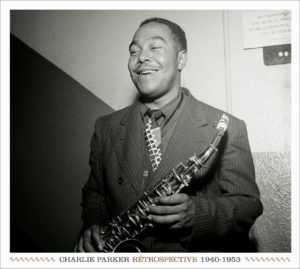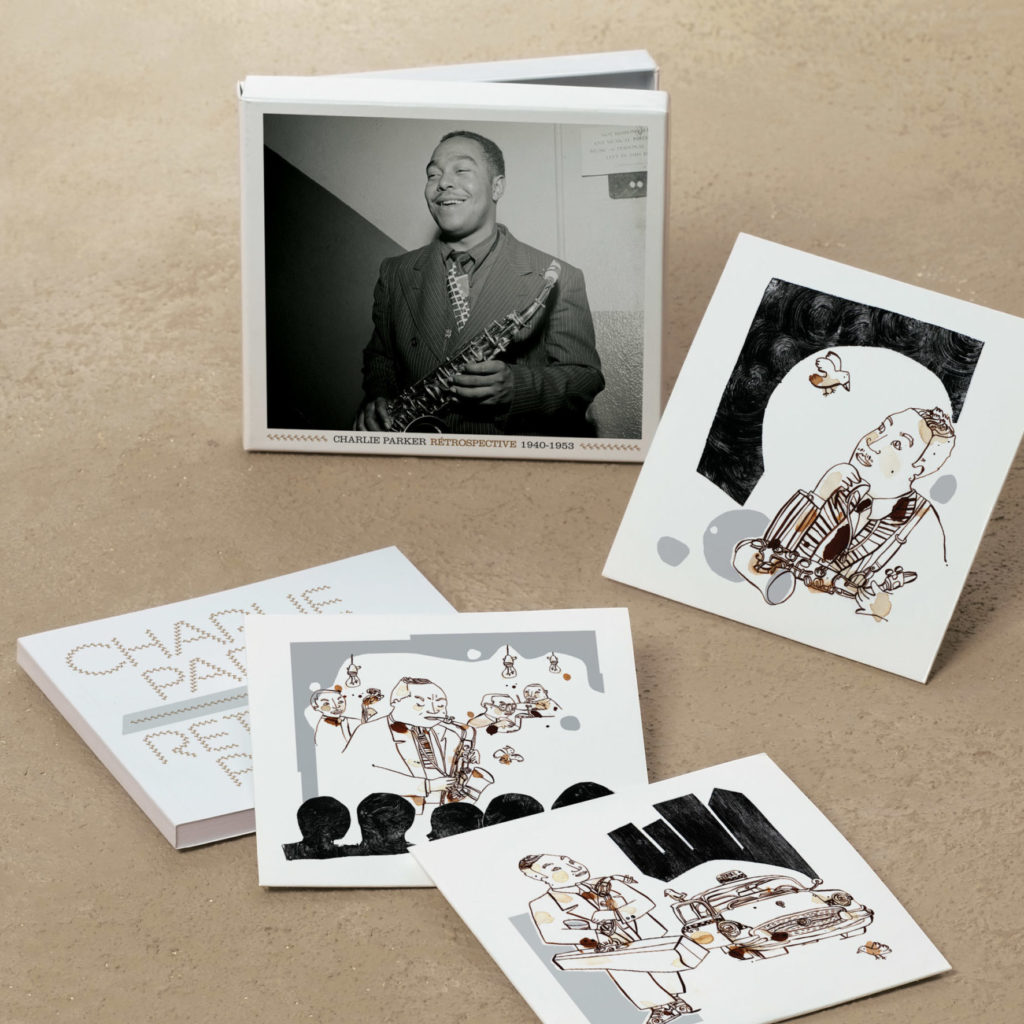
Retrospective 1940-1953
“BIRD LIVES!”
Ce graffiti tracé, à la disparition de Charlie ‘Bird’ Parker, sur les murs de New York tenait alors de l’exorcisme. Aujourd’hui il prend des allures de prophétie. Bousculant ses habitudes harmoniques, mélodiques et rythmiques autant que l’avait fait avant lui Louis Armstrong, Parker ne laissa pas le jazz dans l’état où il l’avait trouvé. Rebelle à toute discipline, victime de son assujettissement aux drogues dures, se comportant souvent de façon irrationnelle, Bird produisit néanmoins une oeuvre éblouissante d’une cohérence sans faille.
Clint Eastwood : “Beaucoup de gens ne comprenaient pas sa musique et quand ils ont commencé à le faire, ils continuaient à se demander comment il arrivait à ce résultat. Charlie Parker restait un mystère.”
Charlie Parker est non seulement le plus grand musicien be bop, il est également un des génies universellement reconnus de l’histoire du jazz. C’est pourquoi, à l’occasion du 50è anniversaire de sa disparition prématurée, le label Saga a souhaité rendre hommage à Bird en élaborant une anthologie d’exception tant par son contenu que sa présentation. Forts du succès critique et commercial du coffret Django Reinhardt Retrospective 1934-1953, nous avons apporté un soin particulier à la préparation de ce second volet de la série “Rétrospective” consacrée aux plus grandes figures du jazz.
Ainsi le texte d’introduction a été confié à Alain Tercinet dont le talent pour raconter les histoires du jazz et de ses héros n’est plus à démontrer. Alain Tercinet est, en effet, auteur de nombreux textes de livret pour les collections “Masters of Jazz”, “Sagajazz” et “Jazz in Paris”, il est également l’auteur d’une biographie de Charlie Parker intitulée Parker’s Mood aux éditions Parenthèses.
Tous les titres ont quant à eux été amoureusement sélectionnés et commentés individuellement par un des plus talentueux et sans aucun doute le plus attachant des saxophonistes français : Daniel Huck, qui a pour l’occasion troqué son alto contre une plume (d’oiseau). L’émotion est au rendez-vous et l’on sent toute l’admiration du musicien dans des textes sincères et inspirés, souvent hilarants et emprunts d’une tendresse toute particulière pour ce génie à qui la musique de jazz doit tant et qui continue d’influencer, aujourd’hui encore, tous les musiciens de jazz.

When Charlie ‘Bird’ Parker disappeared, this graffiti on the walls of New York was an exorcism. Today, it takes on the appearance of a prophecy. Shaking up his harmonic, melodic and rhythmic habits as much as Louis Armstrong had done before him, Parker did not leave jazz in the state he had found it. A rebel against all discipline, a victim of his addiction to hard drugs, often behaving irrationally, Bird nevertheless produced a dazzling body of work of flawless consistency.
Clint Eastwood: “A lot of people didn’t understand his music, and when they started doing it, they kept wondering how he came up with it. Charlie Parker remained a mystery.”
Charlie Parker is not only the greatest bebop musician, he’s also one of the most universally recognized geniuses in jazz history. That’s why, to mark the 50th anniversary of his untimely death, the Saga label has decided to pay tribute to Bird with an anthology of exceptional content and presentation. On the strength of the critical and commercial success of the Django Reinhardt Retrospective 1934-1953 box set, we took particular care in preparing this second instalment in the “Retrospective” series devoted to the greatest figures in jazz.
The introductory text has been entrusted to Alain Tercinet, whose talent for telling the stories of jazz and its heroes is well established. Alain Tercinet is the author of numerous booklet texts for the “Masters of Jazz”, “Sagajazz” and “Jazz in Paris” collections, as well as a biography of Charlie Parker entitled Parker’s Mood, published by Parenthèses.
All the tracks have been lovingly selected and individually commented on by one of the most talented and undoubtedly endearing of French saxophonists: Daniel Huck, who has swapped his alto for a (bird) feather for the occasion. The emotion is there for all to hear, and the musician’s admiration is evident in his sincere and inspired lyrics, often hilarious and full of tenderness for this genius to whom jazz music owes so much, and who continues to influence all jazz musicians to this day.
CD1 – 1940-1947
01 – Swingmatism
02 – Hootie Blues
03 – Tiny’s Tempo
04 – Groovin’ High
05 – All the Things You Are
06 – Dizzy Atmosphere
07 – Salt Peanuts
08 – Shaw ‘Nuff
09 – Hot House
10 – Hallelujah
11 – Slam Slam Blues
12 – Congo Blues
13 – Billie’s Bounce
14 – Ko Ko
15 – Slim’s Jam
16 – Yardbird Suite
17 – Ornithology
18 – A Night in Tunisia
19 – The Famous Alto Break
20 – Cool Blues
21 – Bird’s Nest
22 – Relaxin’ at Camarillo
23 – Chasin’ the Bird
24 – Honeysuckle Rose / Body and Soul
CD2 – 1947-1951
01 – Donna Lee
02 – Milestones
03 – Little Willie Leaps
04 – The Hymn
05 – Scrapple from the Apple
06 – My Old Flame
07 – Don’t Blame Me
08 – Bongo Beep
09 – How Deep is the Ocean?
10 – Bird Gets the Worm
11 – Barbados
12 – Ah-Leu-Cha
13 – Parker’s Mood
14 – Perhaps
15 – Marmaduke
16 – Visa
17 – April in Paris
18 – Bloomdido
19 – Leap Frog
20 – Out of Nowhere
21 – Au Privave
22 – Star Eyes
23 – My Little Suede Shoes
24 – Lover Man
CD3 – Broadcasts and live
01 – Ko Ko
02 – Hot House
03 – On a Slow Boat to China
04 – Confirmation
05 – Embraceable You
06 – Cheryl
07 – Bird of Paradise
08 – Blue ‘n’ Boogie
09 – Anthropology
10 – ‘Round Midnight
11 – Lester Leaps in
12 – Cool Blues
13 – Salt Peanuts
14 – Wee
